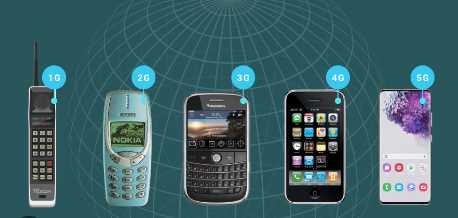After the first generation mobile network was introduced in the early 1980s, the mobile wireless communication system underwent various stages of evolution over the following few decades. Mobile communication standards progressed quickly to support more users due to the enormous global demand for more connections. Let's examine the stages of wireless communication technology development for mobile devices.
The evolution of wireless technology
In 1895, the Italian inventor Marconi used radio waves to wirelessly broadcast Morse code communications over 3.2 kilometres. In scientific history, it was the first wireless broadcast. Since then, engineers and scientists have been attempting to develop an effective RF wave-based communication system.Midway through the 19th century, telephone use began to grow. Engineers began working on a gadget that does not require a wired connection and transmits voice using radio waves as a result of limited mobility and wired connections.
Evolution starts with the creation of the first mobile phone.
The first generation mobile phone was created by Motorola engineer Martin Cooper in the 1970s while he was working on a handheld device capable of wireless two-way communication. The first prototype, which was tested in 1974, was originally created for use in a car.This innovation is regarded as a turning point for wireless communication since it sparked the development of numerous new technologies and industry standards.
First generation mobile communication system (1G)
In Tokyo in 1979, NTT, a Japanese telecommunications corporation, introduced the country to the first generation of mobile networks. It became more well-known in the US, Finland, the UK, and Europe around the start of the 1980s.Due to the limitations of technology, this method, which employed analogue transmissions, had many drawbacks.
Second-generation GSM communication system
Known as the Global System for Mobile communication, the second generation of mobile communication systems included a new digital technology for wireless transmission (GSM). Later, when wireless standards evolved, GSM technology served as the foundational standard. This standard can support data rates of up to 14.4 to 64 kbps (maximum), which is adequate for SMS and email services.In the middle of the 1990s, Qualcomm introduced and put into use its Code Division Multiple Access (CDMA) system. When comparing spectral efficiency, user count, and data rate, CDMA and GSM have more characteristics.
2.75 and 2.5 GHz systems
General Packet Radio Service (GPRS), which was developed and successfully put into use, was introduced to accommodate faster data rates. GPRS has a maximum data rate of 171 kbps (maximum).Enhanced Data with EDGE GSM Evolution was created in order to increase the data rate for GSM networks. EDGE could support up to 473.6 kbps (maximum).In order to accommodate larger data rates for CDMA networks, CDMA2000, another well-known technology, was also launched. This technology is capable of providing data rates of up to 384 kbps (maximum).
Third-generation communications technology
UMTS - Universal Mobile Terrestrial / Telecommunication Systems - marked the beginning of third generation mobile communication. With UMTS, video calling is now supported on mobile devices for the first time at a data rate of 384 kbps.
Smart phones gained popularity all over the world after the launch of the 3G mobile communication system. To handle multimedia chat, email, video calling, games, social media, and healthcare, specific applications were created for cellphones.
Fourth-generation mobile phone technology
The IEEE created 4G systems, which are improved versions of 3G networks that offer faster data rates and the ability to handle more sophisticated multimedia services. The fourth generation of systems uses LTE and LTE advanced wireless technology. Additionally, it is backwards compatible with older versions, making it possible to update and install LTE and LTE Advanced networks more easily.
The LTE system allows for simultaneous voice and data transfer, greatly enhancing data rate. IP packets can be used to transport any service, including voice services. To increase uplink and downlink capacity, complicated modulation methods and carrier aggregation are used.To improve data throughput and network performance, the 4G system introduces wireless transmission technologies like WiMax.
Five-generation communications system, or 5G
Advanced technologies are being used by the 5G network to provide clients with extremely fast internet and multimedia experiences. Future LTE Advanced networks will upgrade to 5G networks with greater speed.Early 5G network deployments will support both standalone and non-standalone operation. LTE and 5G-NR airwaves will be utilised in conjunction in non-standalone mode. In a non-standalone mode, control signalling will be connected to the LTE core network.
For solo mode, a dedicated 5G core network with increased capacity will be available. In the early stages of 5G network rollout, FR1 sub-6 GHz spectrum is employed.Millimeter waves and unlicensed airwaves will be used by 5G technology to transmit data at a greater rate. For the Internet of Things, a complex modulation technique has been devised to enable high data rates.Applications for autonomous driving, healthcare, and security will all benefit from expanded functionality and analytical capabilities thanks to cloud-based network architecture.
Final observations
In order to satisfy rising demand and more stringent specifications, wireless technology has been continuously developing. The telecommunications sector has faced many new issues since the rollout of first-generation mobile networks, particularly in terms of technology, effective spectrum usage, and most crucially, end-user security. Mobile networks will be extremely fast, feature-rich, and highly secure thanks to future wireless technology.




Leave Comment